 I was listening to the BBC Newshour earlier this week and heard an interesting story about the rise of a new class of race cars: Forumla E. This class, which uses only electric-powered cars, was conceived in 2011, and had its first championship in Beijing in 2014. Since the beginning of the series, the cars have certainly come a long way. Initially, the Formula E cars did not carry enough of a battery charge to last a full race, and drivers had to switch cars at about the half-way point. That doesn’t exactly give the sport a whole lot of continuity. However, the newest cars can carry a charge lasting a full race and then some. The cars certainly do not look like your average electric car. This season’s cars, manufactured by Renault, BMW, and Nissan, look similar to a Formula-1 car, can accelerate quite quickly, and reach top speeds of nearly 175 MPH. The cars, unlike their gas-powered cousins, do not release pollutants into the air, and do not require ear plugs for fans in attendance. The popularity of the series has grown, with Mercedes-Benz and Porsche set to join the ranks as manufacturers for next season. This season alone, Formula E raced in 20 cities across 5 continents, with its crowds growing every year. This certainly sounds like an interesting take on the world’s love affair with racing. And now on to this week’s news.
I was listening to the BBC Newshour earlier this week and heard an interesting story about the rise of a new class of race cars: Forumla E. This class, which uses only electric-powered cars, was conceived in 2011, and had its first championship in Beijing in 2014. Since the beginning of the series, the cars have certainly come a long way. Initially, the Formula E cars did not carry enough of a battery charge to last a full race, and drivers had to switch cars at about the half-way point. That doesn’t exactly give the sport a whole lot of continuity. However, the newest cars can carry a charge lasting a full race and then some. The cars certainly do not look like your average electric car. This season’s cars, manufactured by Renault, BMW, and Nissan, look similar to a Formula-1 car, can accelerate quite quickly, and reach top speeds of nearly 175 MPH. The cars, unlike their gas-powered cousins, do not release pollutants into the air, and do not require ear plugs for fans in attendance. The popularity of the series has grown, with Mercedes-Benz and Porsche set to join the ranks as manufacturers for next season. This season alone, Formula E raced in 20 cities across 5 continents, with its crowds growing every year. This certainly sounds like an interesting take on the world’s love affair with racing. And now on to this week’s news.
- Germany’s first electric highway charges trucks as they drive
- Self-driving trucks begin mail delivery test for USPS
- Supreme Court rejects UPS appeal that USPS should raise rates
- Ford’s delivery robot walks like a human
- Amazon turns warehouse tasks into video games to make work “fun”
- US-China trade war creating boom for Chinese logistics companies
- Be wary of increased cargo theft activity over Memorial Day weekend
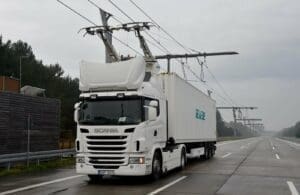 Germany, after testing the initiative earlier this year, has officially opened its first “electric highway” which connects hybrid trucks with overhead wires to charge the trucks as they drive. The system was built by Munich-based engineering firm Siemens AG, while Volkswagen AG’s Scania trucks unit provided the vehicles. The technology is similar to that of a train, where the trucks can link up to the overhead cables and charge while driving up to 90 KPH. The trucks can then drive on their electrically charged battery, with a diesel motor kicking in once the battery has been depleted. Currently there is one truck using the 10 kilometer stretch of highway with four more in the works by the end of 2020.
Germany, after testing the initiative earlier this year, has officially opened its first “electric highway” which connects hybrid trucks with overhead wires to charge the trucks as they drive. The system was built by Munich-based engineering firm Siemens AG, while Volkswagen AG’s Scania trucks unit provided the vehicles. The technology is similar to that of a train, where the trucks can link up to the overhead cables and charge while driving up to 90 KPH. The trucks can then drive on their electrically charged battery, with a diesel motor kicking in once the battery has been depleted. Currently there is one truck using the 10 kilometer stretch of highway with four more in the works by the end of 2020.
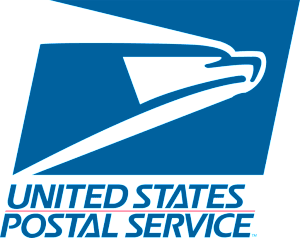 Earlier this week, the USPS started a two-week test with autonomous trucks. The pilot will use self-driving trucks from San Diego-based start-up TruSimple to haul mail between USPS facilities in Phoenix and Dallas. The goal is to see how the autonomous driving technology can impact both delivery times and costs. The pilot will involve five round-trip hauls between the facilities, totaling more than 2,100 miles and 45 hours of driving each. The trucks will travel on major interstates and pass through Arizona, New Mexico, and Texas. A driver will be in the cab along with an engineer should any problems arise on the trips. USPS has not indicated whether the program will continue after the initial two-week pilot.
Earlier this week, the USPS started a two-week test with autonomous trucks. The pilot will use self-driving trucks from San Diego-based start-up TruSimple to haul mail between USPS facilities in Phoenix and Dallas. The goal is to see how the autonomous driving technology can impact both delivery times and costs. The pilot will involve five round-trip hauls between the facilities, totaling more than 2,100 miles and 45 hours of driving each. The trucks will travel on major interstates and pass through Arizona, New Mexico, and Texas. A driver will be in the cab along with an engineer should any problems arise on the trips. USPS has not indicated whether the program will continue after the initial two-week pilot.
 Speaking of the USPS, the US Supreme Court has denied an appeal by UPS that USPS should raise its rates for package delivery. The justices left intact an appeals court decision upholding the government’s method for determining how much the Postal Service can charge for parcels. Amazon, which heavily relies on USPS for package delivery, backed USPS in its court case. UPS has said that USPS has an unfair advantage because the pricing method doesn’t track the true cost of delivering packages. While the Supreme Court may have struck down the appeal, it doesn’t mean that USPS’ prices won’t go up. President Trump recently appointed a task force which recommended that USPS raise its prices.
Speaking of the USPS, the US Supreme Court has denied an appeal by UPS that USPS should raise its rates for package delivery. The justices left intact an appeals court decision upholding the government’s method for determining how much the Postal Service can charge for parcels. Amazon, which heavily relies on USPS for package delivery, backed USPS in its court case. UPS has said that USPS has an unfair advantage because the pricing method doesn’t track the true cost of delivering packages. While the Supreme Court may have struck down the appeal, it doesn’t mean that USPS’ prices won’t go up. President Trump recently appointed a task force which recommended that USPS raise its prices.
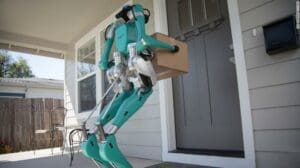 Ford has been getting innovative when it comes to last-mile deliveries, partnering with multiple companies recently on self-driving cars to make deliveries. Now, the company is experimenting with a delivery robot that will deliver packages from its recently developed autonomous vehicles. Delivery robots have been in the news quite a bit lately a well, with most versions resembling a pod on wheels. The trouble, as Ford sees it with these delivery robots, is that they require consumers to come outside to retrieve their package. Ford partnered with Agility Robotics, an Albany, Oregon-based startup that makes a human-like robot capable of carrying 40-pound packages. The robot can climb stairs, walk on uneven terrain, and stay balanced if it is bumped. If the robot gets confused while carrying a package, it will communicate with Ford’s vehicles for guidance. Ford declined to say if or when it will launch a commercial delivery program with the robots.
Ford has been getting innovative when it comes to last-mile deliveries, partnering with multiple companies recently on self-driving cars to make deliveries. Now, the company is experimenting with a delivery robot that will deliver packages from its recently developed autonomous vehicles. Delivery robots have been in the news quite a bit lately a well, with most versions resembling a pod on wheels. The trouble, as Ford sees it with these delivery robots, is that they require consumers to come outside to retrieve their package. Ford partnered with Agility Robotics, an Albany, Oregon-based startup that makes a human-like robot capable of carrying 40-pound packages. The robot can climb stairs, walk on uneven terrain, and stay balanced if it is bumped. If the robot gets confused while carrying a package, it will communicate with Ford’s vehicles for guidance. Ford declined to say if or when it will launch a commercial delivery program with the robots.
 Reports have shown that conditions in Amazon’s warehouses are generally less-than-ideal. As a result, the company is looking at ways to improve the working conditions and make employees’ lives easier. Specifically, Amazon is looking to gamification to achieve this goal. Gamification is the application of game-like elements into non-game situations. Amazon has started installing screens next to workers’ stations that feature simple games with names like PicksInSpace, Mission Racer, and CastleCrafter. Their physical actions, assembling orders and moving items, are translated into virtual in-game moves. So, the faster someone picks items and places them in a box, for example, the faster their car will move around a virtual track. The games are geared towards making the tasks less tedious while instilling a sense of competition to make employees more efficient. The games are voluntary and have so far been installed in five warehouses in the US and the UK.
Reports have shown that conditions in Amazon’s warehouses are generally less-than-ideal. As a result, the company is looking at ways to improve the working conditions and make employees’ lives easier. Specifically, Amazon is looking to gamification to achieve this goal. Gamification is the application of game-like elements into non-game situations. Amazon has started installing screens next to workers’ stations that feature simple games with names like PicksInSpace, Mission Racer, and CastleCrafter. Their physical actions, assembling orders and moving items, are translated into virtual in-game moves. So, the faster someone picks items and places them in a box, for example, the faster their car will move around a virtual track. The games are geared towards making the tasks less tedious while instilling a sense of competition to make employees more efficient. The games are voluntary and have so far been installed in five warehouses in the US and the UK.
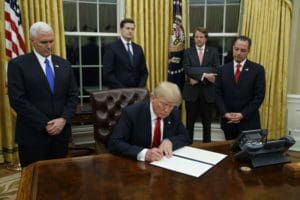 The ongoing trade war between the US and China has led to tariffs, more tariffs, retaliatory tariffs, and lots of escalating rhetoric. So far, the trade war has resulted in increased prices, manufacturing changes, and a volatile stock market. But there has been one surprise winner in all of this: Chinese logistics companies facilitating the exodus manufacturers looking to avoid tariffs. The trade war has accelerated the trend of Chinese manufacturers moving operations to Vietnam, Taiwan, Cambodia, Thailand and other parts of Southeast Asia. The logistics companies that have cross-border capabilities have been there to move these operations and are reaping the rewards. The latest round of tariffs left many companies scrambling to get out of China, ensuring business for these logistics companies. With tensions continuing to rise, and more tariffs coming, these logistics firms should have plenty of work for the foreseeable future.
The ongoing trade war between the US and China has led to tariffs, more tariffs, retaliatory tariffs, and lots of escalating rhetoric. So far, the trade war has resulted in increased prices, manufacturing changes, and a volatile stock market. But there has been one surprise winner in all of this: Chinese logistics companies facilitating the exodus manufacturers looking to avoid tariffs. The trade war has accelerated the trend of Chinese manufacturers moving operations to Vietnam, Taiwan, Cambodia, Thailand and other parts of Southeast Asia. The logistics companies that have cross-border capabilities have been there to move these operations and are reaping the rewards. The latest round of tariffs left many companies scrambling to get out of China, ensuring business for these logistics companies. With tensions continuing to rise, and more tariffs coming, these logistics firms should have plenty of work for the foreseeable future.
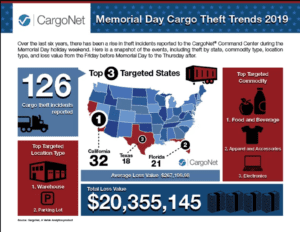 And finally, this weekend is Memorial Day weekend in the US. It is generally seen as the beginning of summer, with cookouts galore across the country. According to cargo theft reporting firms SensiGuard and CargoNet it is also a weekend of increased theft activity. During the Memorial Day periods between 2013 and 2018, CargoNet received reports of 126 cargo thefts in the US and Canada in 24 states and provinces, with cargo theft most commonly occurring on Friday and Saturday during that six-year period. Both firms recommend drivers and fleets avoid leaving loads unattended in high-theft metropolitan areas and by using secured lots. Drivers should also look out for vehicles following them as they leave warehouses with goods and contact police to report any suspicious activity.
And finally, this weekend is Memorial Day weekend in the US. It is generally seen as the beginning of summer, with cookouts galore across the country. According to cargo theft reporting firms SensiGuard and CargoNet it is also a weekend of increased theft activity. During the Memorial Day periods between 2013 and 2018, CargoNet received reports of 126 cargo thefts in the US and Canada in 24 states and provinces, with cargo theft most commonly occurring on Friday and Saturday during that six-year period. Both firms recommend drivers and fleets avoid leaving loads unattended in high-theft metropolitan areas and by using secured lots. Drivers should also look out for vehicles following them as they leave warehouses with goods and contact police to report any suspicious activity.
That’s all for this week. Enjoy the long weekend and the song of the week, the Electric Six’s Danger! High Voltage.

















